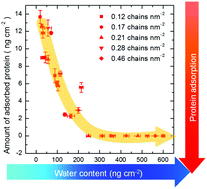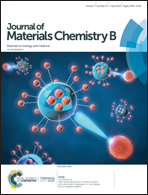A negative correlation between water content and protein adsorption on polymer brushes†
Abstract
The correlation between the water content and protein adsorption on the surface of polymer brushes is investigated quantitatively. Using a number of model systems such as poly N-isopropylacrylamide (PNIPAM), polyethylene glycol (PEG), poly(2-(methacryloyloxy)ethyl phosphorylcholine) (PMPC), poly(2-hydroxyethyl methacrylate) (PHEMA), and poly(2,2,3,4,4,4-hexafluorobutyl)methacrylate (PHFBMA) polymer brushes with various grafting densities, the amount of water hydrodynamically coupled inside the brushes and its correlation with protein adsorption (BSA and Fg proteins as model systems) were determined by quartz crystal microbalance with dissipation (QCM-D) and surface plasma resonance (SPR). The results demonstrate the negative correlation between the water content and protein adsorption – the more water is coupled inside the brushes, the more protein adsorption is suppressed. In particular for PNIPAM brushes with a high enough grafting density and with a water content greater than 250 ng cm−2, the protein adsorption is negligible.



 Please wait while we load your content...
Please wait while we load your content...